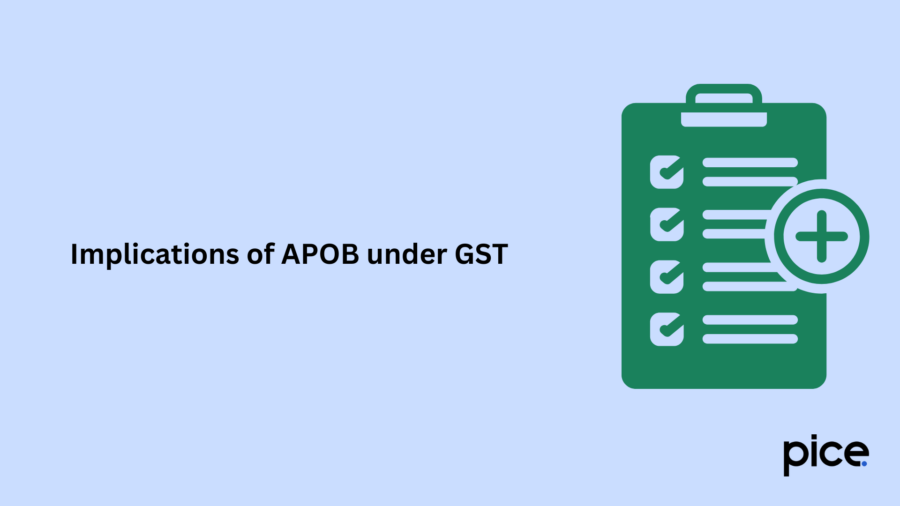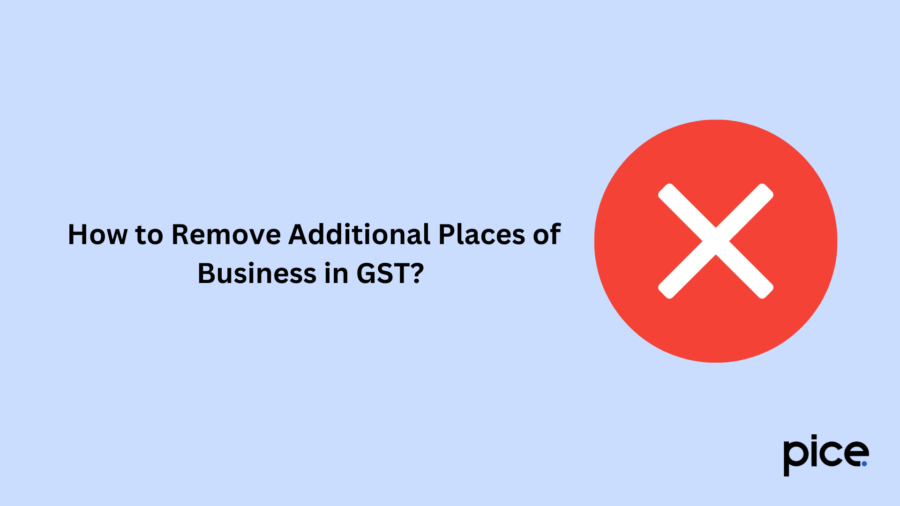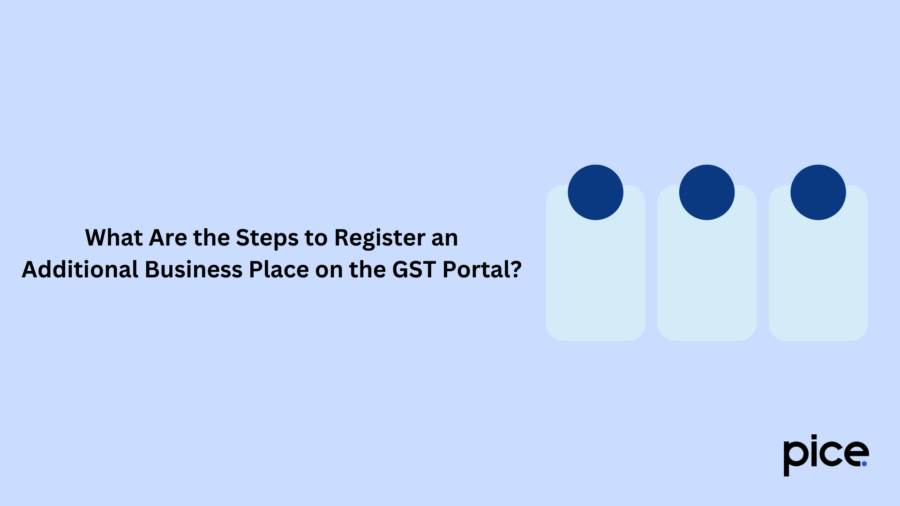How to Remove Additional Place of Business in GST: A Guide
- 20 Feb 25
- 12 mins

How to Remove Additional Place of Business in GST: A Guide
- Implications of APOB under GST
- Benefits of Additional Places of Business Under GST
- GST Registration Requirements for Additional Places of Business
- Steps to Add an Additional Place of Business on the GST Portal
- How to Remove Additional Places of Business in GST?
- What Are the Documents Needed for Additional Place GST Registration?
- What Are the Steps to Register an Additional Business Place on the GST Portal?
- Conclusion
Key Takeaways
- GST Registration is Mandatory for any additional business location.
- Separate Tax Records must be maintained for each location.
- Easy Online Process to add or remove APOB via the GST portal.
- ITC Benefits help reduce tax liabilities for registered locations.
- Avoid Penalties by ensuring timely GST compliance.
In today’s world of taxation, adaptability is a vital feature to achieve success in business. Under several situations, companies might need to expand and establish branches at different locations. Here comes the importance of understanding the registration process of an additional place of business under the GST framework.
Increasing the size of a business sometimes can be a sign of which direction successful companies move. Whether it is entering into a new market base, satisfying the customer's needs or improving operational capacity, companies find themselves at some point where setting up an ancillary place of business becomes unavoidable.
Continue reading this blog to gain detailed insights about how to add and how to remove additional place of business in GST and their key implications.
Implications of APOB under GST

Businesses must register both their primary place of business and any additional locations under the GST. The principal place of business and the APOBs will be mentioned in the registration certificate, which a taxable person with an APOB must declare at the time of GST registration. For each APOB, the taxable person must get a separate registration.
One impact of an APOB is that the taxable person is required to have separate books of account for each business location including the APOBs. This means that the books of account for every APOB require documentary proof of every transaction that occurs in each business venture. Suddenly, the taxed individual is mandated to file different Goods and Service Tax (GST) returns based on every APOB.
It is important to note that determining the place of supply for each transaction is the responsibility of the taxable person, based on the supplier's location and the transaction's place of supply. If the transaction takes place at an APOB, the APOB will serve as the place of supply, and GST will be levied accordingly.
Benefits of Additional Places of Business Under GST
There are several benefits of adding additional places of business under GST. It is also essential to carry out smooth and efficient operations and ensure transparency. Here are some key benefits of additional places of business under GST:
- Legal Compliance: Following the GST law, if a business operates in multiple places, apart from its main place of business, it is mandatory for the business to mention its other business places under additional places of business. Failing to follow this can lead to non-compliance issues and legal consequences.
- Liability of Taxes: Every additional place of business possesses different tax liabilities and fresh registration allows for the determination of the correct tax obligations for individual locations. Looking into tax liabilities is essential for businesses functioning in different states, as they mostly abide to state state-specific GST regulations.
- Input Tax Credit (ITC): Registration of additional places of business enables businesses to claim input tax credit on the GST amount payable for goods and services used at specific locations. This thereby ensures that businesses can offset their tax liabilities effectively.
- Ease of Compliance: Registering for additional places of business helps streamline the compliance process. Businesses thus can file GST returns, complete payment of taxes for each location, maintain records and cope with tax-related responsibilities with ease.
- Avoiding Penalties: Non-compliance with GST regulations imposes high penalties. Thus, through the registration of additional places of business, each business can prevent further fines and penalties.
GST Registration Requirements for Additional Places of Business
Growing your company is a calculated move with the aim of building up the operations of the business firm. When a business wants to grow and switch to a new additional business place, perhaps a new site, it engages in an exhilarating mission with ease of access and better organizational productivity.
However, these new journey advantages should place a major focus on the recognition and assurance of tax compliance mainly under the
existing GST structure.
The introduction of GST in India has brought considerable changes in the overall taxation system in the country. Several indirect taxes were eliminated and were substituted by a single tax system that made the system more orderly. Here both – the state and central government have also imposed taxes which maintain transparency and equal structure of taxes.
In India, all businesses must undergo a GST registration. This registration moreover becomes mandatory when their aggregate turnover exceeds the desired threshold. However, when a business functions from different locations, it is essential to gain a thorough understanding of the registration process of an additional place of business for GST.
Irrespective of whether it is a warehouse, showroom or manufacturing unit, each of these locations should adhere to the GST regulations.
Steps to Add an Additional Place of Business on the GST Portal
Any registered normal taxpayers, after getting registration under GST, can make certain alterations to the GST registration details form through an application for amendment of registration. Adding any place of business doesn’t fall under the non-core field amendment.
Here are the detailed steps to follow about how to add an additional place of business details on the GST portal:
1. Visit the official GST portal and navigate to the Service section > Registration option and further choose the amendment of registration core field.
2. Numerous tabs are displayed on the screen for editing. Click on the tab entitled 'Additional Place of Business'.
3. You will be redirected to a new page, where you need to click on the 'Add New' button. Make sure to provide all relevant information along with the reason for the amendment and the date of the amendment. Further, click on 'Save'.
Provide your PIN code, business address or latitude, longitude and other alpha values in numerals. Once you complete entering 2 characters minimum, auto suggestions appear on the screen in the search box entitled 'Enter Address or Latitude, Longitude' displayed in the right corner.
4. Click on the checkbox for verification and enter the name of the authorized signatory from the drop-down list.
5. Provide the place and choose the option of signing the GST registration application form digitally.
6. Once your submission procedure is completed, you will receive a message on the screen stating 'Successful Submission'. Moreover, an acknowledgement slip will be issued to your respective e-mail ID and mobile number within 15 minutes. The tax official, however, needs to approve the amendment to the core field.
Alongside this, you will also receive an approval or rejection of the application form through SMS and email to the registered email
address and contact details.
How to Remove Additional Places of Business in GST?

Here are the steps to follow for removing additional places of business in Form GST:
1. Go to the GST official website and navigate to the 'Services' tab located on the dashboard.
2. Choose ‘Registration’ located under the services menu and then go to ‘Amendment of Registration’.
3. Fill in relevant details of your additional place of business you wish to remove.
4. Once you are done filling up the application form, hit the 'Submit' button and an Application Reference Number (ARN) will be
generated.
5. Your application will further be reviewed and once verified, you will receive a confirmation message within a few days.
When Is GST Registration Needed for Additional Places of Business?
Whenever a new business starts a new additional place of business such as a warehouse, branch, factory, etc., GST registration is mandatory. This process is essential regardless of turnover. The businesses should file the required registration certificate form on the official GST portal for registration of the additional place.
What Are the Documents Needed for Additional Place GST Registration?
Here is a detailed overview of documents you need for adding an additional place of business in the Goods and Services Tax (GST) system:
- Proof of Address: This includes documents such as a lease agreement, a rental agreement, or a utility bill for registration of the additional place of business.
- No Objection Certificate (NOC): If your property is on rent, you might need an NOC from the landlord to provide permission for the use of premises for carrying out business activities.
- Ownership Proof: Owning the property requires presenting some mandatory documents such as a title deed, property-related papers and a possession letter.·
- Authorization Letter: A letter of authorization is issued from the place of business for authorizing the functioning of an additional place of business GST Registration.
- Certificate: A copy of the existing registration certificate of GST is mandatory.
- Details of Bank: Bank account details of the additional place of business are Once your submission procedure is completed, you will receive a message on the screen stating 'Successful Submission'. Moreover, an acknowledgement slip will be issued to your respective e-mail ID and mobile number within 15 minutes. The tax official, however, needs to approve the amendment to the core field.essential.
- ID and Address Proof: Address and ID proof of the authorised digital signatory is mandatory to present.
What Are the Steps to Register an Additional Business Place on the GST Portal?

The registration process for an additional place of business on the GST portal is a simple and easy task. Let's explore the following steps to complete the process hassle-free:
1. Go to the official GST common portal and log into your account providing your GSTIN and password.
2. Choose the ‘Services’ tab located on the portal.
3. For accessing the 'Amendment of Registration', first and foremost visit the 'Services' tab and go to the dedicated section to complete the amendment in GST registration.
4. Now, to begin with the registration process, choose the option 'Add Additional Place of Business' located under the section titled 'Choose'. Completing this action will let you move forward and complete the necessary steps of application for registration amendment.
5. Retrieve the necessary information relating to the additional place of business. This information includes proof of ownership or occupancy, address, details of bank account, and an authorization letter for the authorised signatory.
6. Make sure to attach all supporting documents and upload the required paperwork. These take into consideration the GSTIN of the primary place of business, PAN card, proof of ownership, details of bank account, and photographs of the additional place(s) of business.
7. Once you complete providing all relevant information with necessary documents, click on the 'Submit' button for document submission.
8. After successful application submission, the concerned tax authorities will now thoroughly review your application form, ensuring all requirements are met. After successful validation, the additional place of business is integrated successfully into your existing GST registration.
9. To ensure the accuracy and compliance of data, make sure to update your information regularly for all locations. However, if the new place of businesses functions differently, it is reliable to maintain a different record and account.
Following the above steps, you can complete registration of the additional place of business. Further, continue exploring how this registration process can result in affecting your tax obligations.
Does a Temporary Business Place Require GST Registration?
Any temporary business place such as a project office or construction site does not need access to GST registration if the operating time period is less than 180 days. However, if the temporary location functions for more than 180 days, it is mandatory to register following the GST laws. During this tenure, businesses must monitor closely their activities to prevent compliance issues with GST regulation.
Conclusion
In summary, new business locations can have the ability to adjust, expand and prosper in a changing tax climate by successfully managing the challenges of GST registration. Businesses can take advantage of input tax credits, optimize operations and investigate new markets, thanks to this process. Their operational stability and efficiency are consequently improved following a definite time limit.
Growing is only one aspect of expanding to new areas. It includes boosting brand visibility, grabbing opportunities and reaching underserved consumer segments. Manufacturers increase manufacturing capacity and efficiency, while retail businesses receive increased foot traffic and revenues.
Businesses that focus on providing services expand their customer base and reach. These ramifications affect sales, marketing, logistics and customer service, among other areas of the company.
💡If you want to streamline your payment and make GST payments via credit card, consider using the PICE App. Explore the PICE App today and take your business to new heights.




















